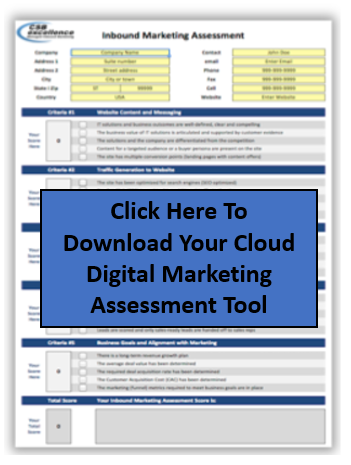As business people, we are all familiar with the age-old concept that acquiring new customers is many times more expensive than retaining existing customers (by some reports 5 to 7 times more expensive). In a ModernMSP's business, the value of customer retention and the contribution of add-on business from an installed base cannot be overstated. However, the fact remains that new customer acquisition is essential to accelerating the growth of a managed services business.
If you are a ModernMSP just starting out, or transforming from a traditional IT Solutions Provider (ITSP) model to an ModernMSP model, then each new cloud customer is critical to growing recurring revenue, building customer references and gaining industry knowledge in your target market segments. Each new customer brings with it a long-term revenue stream that adds stability to your business. Most important, as you add profitable customers using an efficient sales and marketing process, you will be increasing your profitability and that directly impacts the valuation investors will assign to your company. If you are an established ModernMSP, you may be looking for growth capital to fund expansion or planning for the day when you sell your business and cash out. When that day comes, your valuation becomes the ultimate report card that determines your financing terms or the purchase price your business will command.
How can you maximize profitability and the valuation of your ModernMSP business?
There are two kinds of profitability to consider - gross profit and net profit. Gross profit is simply the amount of money generated by your managed service fees after subtracting the cost of service delivery. Over the years, ITSPs (ModernMSPs didn't exist years ago) have spent a ton of time and effort maximizing their gross margins by wringing as much cost out of service delivery as possible. However, many make a big mistake … they believe that by maximizing their gross margins, they have maximized their profitability. The problem is that gross margin improvement is only half the battle. In order to truly increase the valuation of your business you need maximize your net profits – the amount of money left over after you subtract all of your operating expenses from gross profit. Operating expenses include sales, marketing and administrative expenses and must be funded by gross margin dollars. Generating a high gross profit only to give it back with high operating expenses is an exercise in futility. If your business produces high gross margins but you are still unable to realize healthy net margins then you are probably suffering from a high cost of customer acquisition. But don’t worry… this is a curable condition.
What is the cure for a high customer acquisition cost?
Before you can cure a high customer acquisition cost, you first have to know how to measure it. After you learn how to measure it, you must monitor it. Then, and only then, can you manage your COC to a more reasonable cost level. Here’s how to measure your Cost of Customer Acquisition:
COC = (Total Selling Expense + Total Marketing Expense)/Gross Margin from New Customers
This calculation provides a standard metric for COC that divides the total monthly cost of acquiring new customers by the gross margin dollars generated by those new customers. Your Total Selling Expense includes the salaries, commissions, overhead and departmental expenses for your outside sales reps, inside sales reps and any other headcount in your sales organization. Total Marketing Expense includes the salaries, bonuses and overhead for the marketing staff as well as the program expenses for lead generation, branding, public relations and producing sales enablement materials. Add up all of these expenses, determine the gross margin dollars from new customers produced during the same period, convert them to a monthly value and input them into the formula above.
The result is a number that represents the number of months it will take to pay back your customer acquisition cost with gross margin dollars. The payback time should be in the range of 6 to 12 months. Sounds simple doesn’t it? Nevertheless, it is surprising how few ITSPs actually calculate their COC. Do you calculate your COC? If so, what is the value of your COC? Is it within the range of 6 to 12 months? How often do you measure it? Is it trending up or down? What are the major cost elements? Are you taking steps to reduce those costs? Knowing how to measure COC is just the first step in maximizing your valuation. The second step is to monitor your COC on a regular basis as one of the key performance metrics for your business. The third step (this is the hard part) is to manage your COC to a minimum value by creating an efficient and repeatable go-to-market model. Then you must faithfully implement this model to scale up your business.
What is your repeatable COC strategy?
If company valuation is the final report card for your business, then COC is the final exam. So the question becomes, what kind of homework should you be doing now to pass your final exam? Your homework starts with marketing and ends with sales. Your marketing homework is to implement a very efficient lead generation process. Start by measuring your cost per lead and your lead conversion rates. Use these conversion rates to track the percentage of unqualified leads that become qualified leads feeding the sales opportunity pipeline and the percentage of sales opportunities that are closed and become new customers. Then put a process in place to continuously improve these metrics. While this is not a hard process to put in place, few MSPs and CSPs proactively manage their lead funnel in this way. Your sales homework is to implement an efficient sales process for tracking the movement of deals through the pipeline in order to compare the performance of each sales rep against a baseline for sales cycle time and close ratio. This approach allows you to manage your sales team by focusing on the deals that need attention and forecasting the deals that are following a normal progression through the pipeline. Sales pipeline management is not hard either, but it’s not a natural or intuitive process for most entrepreneurs who are cut from a technical bolt of cloth.
Developing a repeatable and scalable COC strategy means building a comprehensive go-to-market plan for your managed services that includes these five building blocks:
- A Formal Strategic Plan
Define your marketing strategy including your target markets, ideal customer profile and differentiated customer value proposition
- A Profitable Business Model
Determine your pricing strategy, service bundling and an economic model for profitable service delivery to a typical customer
- An Effective Marketing Machine
Create compelling content and execute efficient lead generation programs to drive the right volume of qualified leads into the pipeline
- Manage a Predictable Sales Process
Establish a process for hiring, enabling and managing a sales function that efficiently and consistently produces results
- Continuously Measure Success
Develop key metrics for measuring sales and marketing effectiveness including the cost of customer acquisition and monitor them continuously
Now ask yourself if you have all five of these areas covered to the best of your ability. If the answer is yes and your COC is within the target range, then you are well positioned to scale your business into a high valuation company. If the answer is no, then you still have more homework to do. Measuring COC is not hard. Implementing a repeatable and low cost COC strategy is harder – but no harder than managing your cost of service delivery. If you can do one, you can certainly do the other.
Want to do deeper on the subject of COC? Check back and we will cover ways to reduce your COC by maximizing the effectiveness and efficiency of your sales and marketing operation. In the meantime, what are your experiences?


